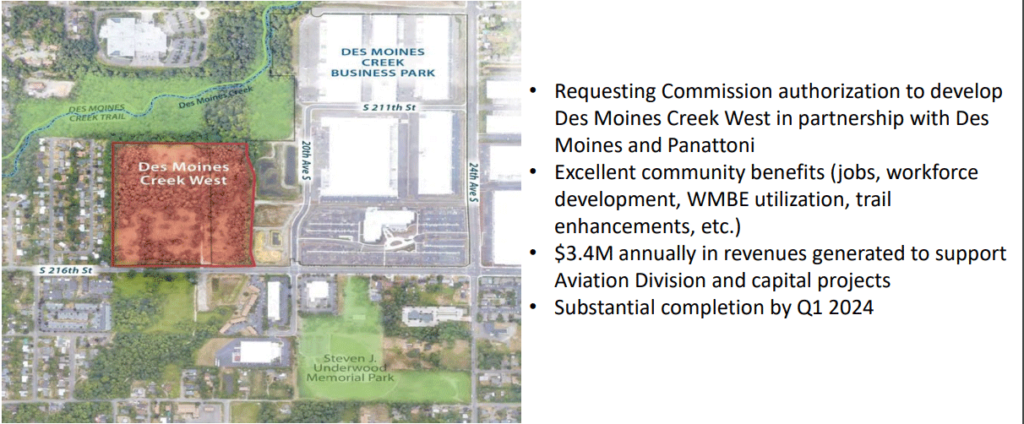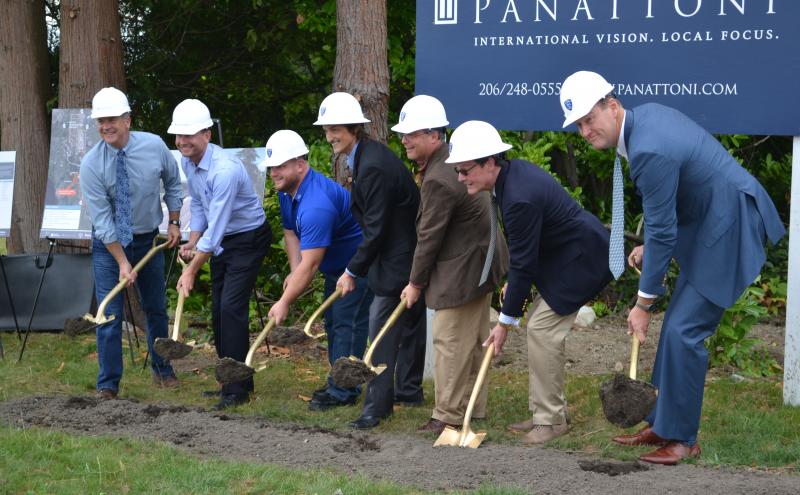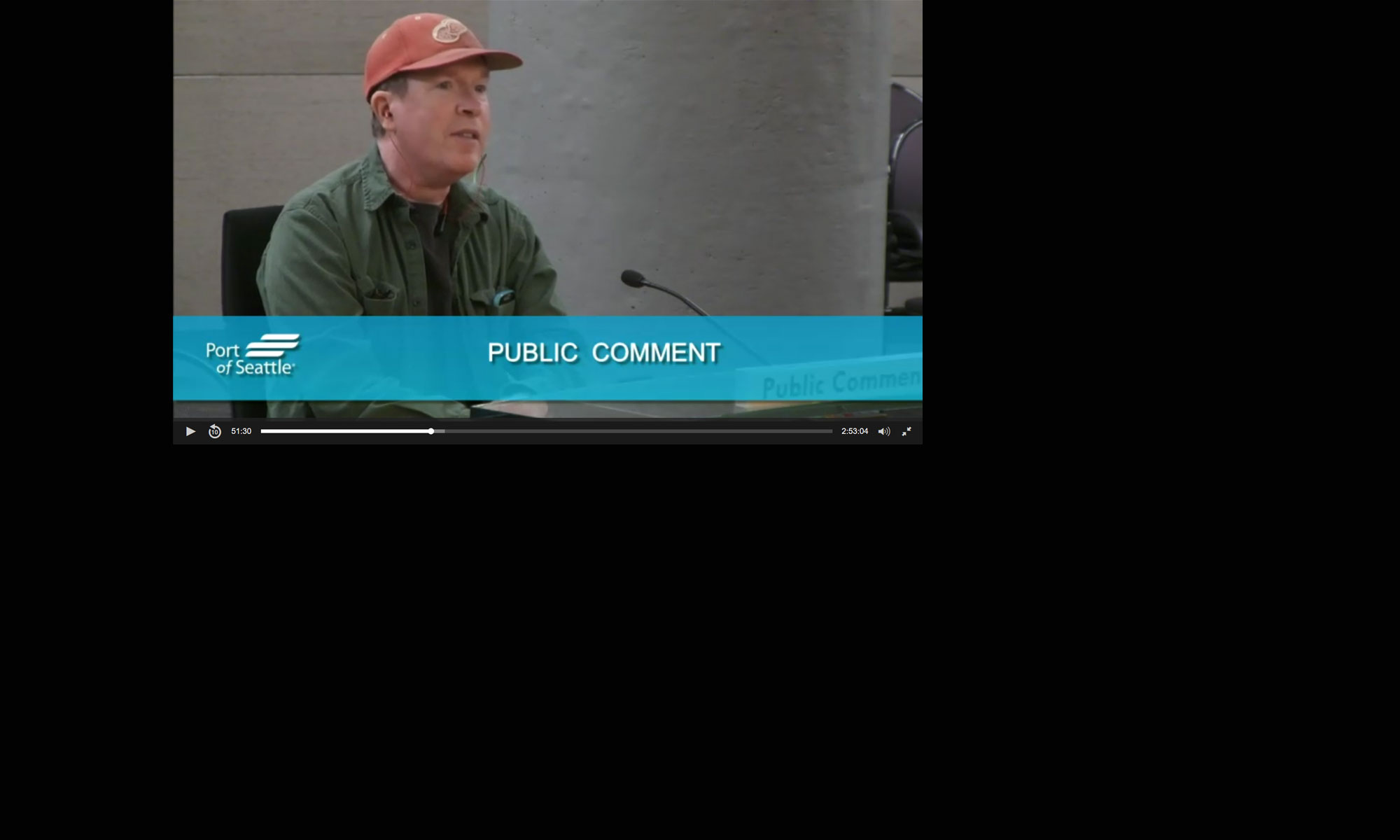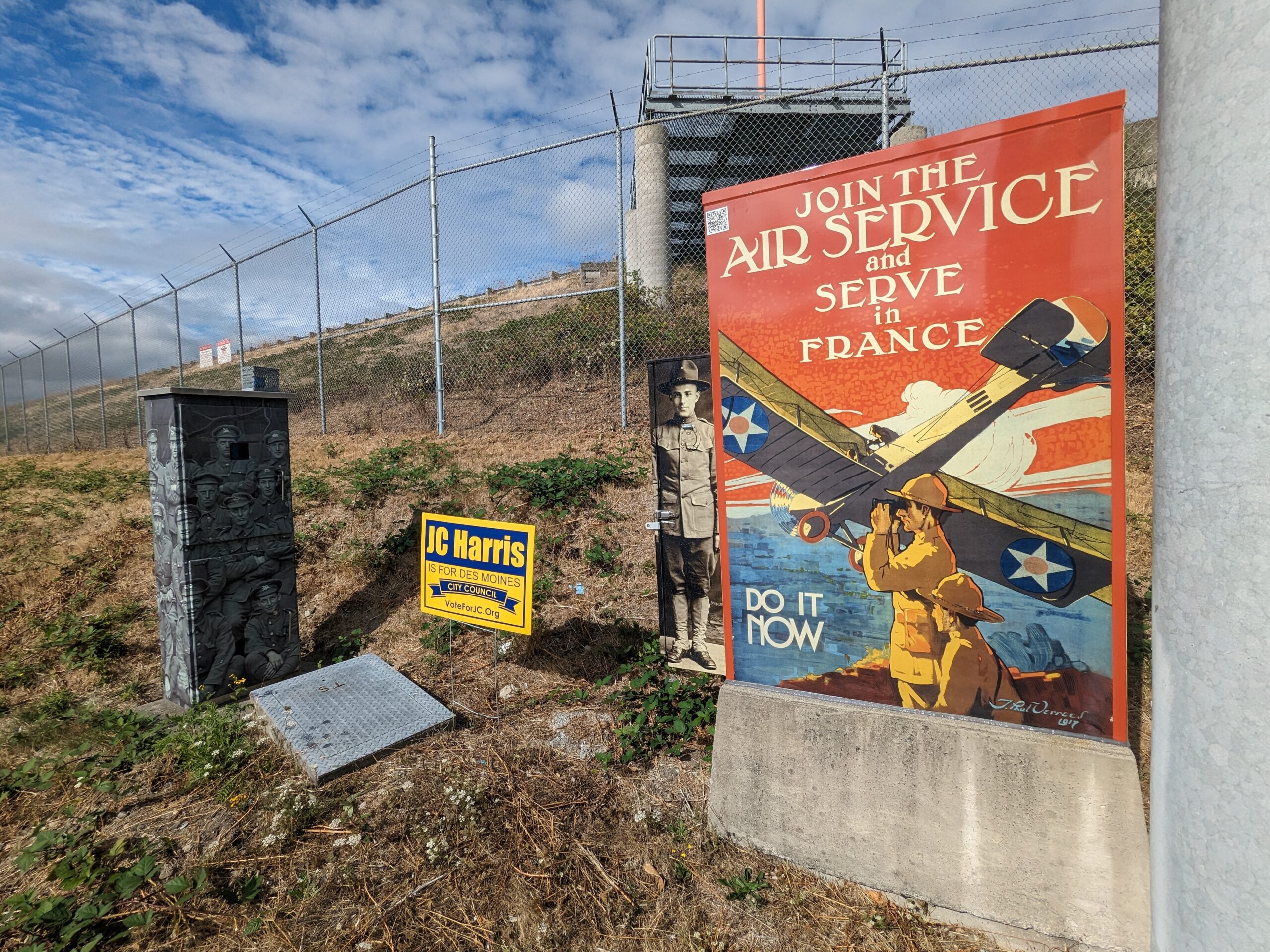I almost titled this post “This is what a sellout looks like” But I restrained myself. 🙂
At the 12 July Port of Seattle Commission Meeting, the Port voted to proceed with the Item 10b (Des Moines Creek West Ground Lease.) (Presentation.) This is the scrubby forest land west of the FAA building on 216th with the road connecting to the Des Moines Creek Trail. It will become Phase V of the Des Moines Creek Business Park (DMBCP).

Des Moines Mayor Mahoney and Deputy Mayor Buxton mentioned all the “jobs” and “economic development”. The Port announced that it was exceeding the City’s current tree code with a 4-1 replacement provision. As Commissioner Cho said, “What’s not to like?”
A few details…
- *As the presenter said, the FAA paid for most of the original land. And WSDOT bought the rest as one of three possible routes for SR-509. There is also a corresponding parcel at the northern end of the Des Moines Creek Trail.
- In 2016, both those north and south parcels were up for auction. The north was offered to the City of SeaTac, the south to the City of Des Moines.
- In 2021, the City of SeaTac bought 8.8 acress on the north side (a large portion of it with a grant from King County), and is converting their end to BMX trails and forest.
- The City of Des Moines turned the 14.4 acre parcel at the south end over to the Port of Seattle, who bought it for about $3,000,000 in 2021. And that leads up to today’s agenda item.
- According to the Port’s real estate manager, the new development will generate over $3.4M in annual lease revenue for the Port.
- The developer is Panattoni Development, the same firm that developed all three previous phases of the DMCBP. Please take a drive around the existing DMCBP and let me know how well they’ve done so far in terms of ‘tree canopy’. A 4-1 replacement program sounds nice until one asks, “How well has the City of Des Moines ever enforced our existing tree code on commercial projects?” (†Spoiler alert below.)
- The Mayor and Deputy Mayor mentioned “jobs” and “economic development.” Please ask the City Manager of Des Moines how much money those existing projects have generated for the City of Des Moines. (I tried to get the City to create such a report and was told that it’s ‘impossible’, despite the fact that other cities do exactly that.
Frankly, I do not care about “jobs” or “economic development” for the Port of Seattle or King County–unless they’re in Des Moines.
What if…
If the City of Des Moines had bought the land, we would have control. We could explore a whole spectrum of development opportunities:
- On one end we could have done as did the City of SeaTac, extended their forest and parks.
- Or, we could have done exactly what the Port of Seattle is doing and then we would have that $3.4M in lease revenue.
Do you have any idea what $3.4M would mean for a City like Des Moines? It’s over 14% of our annual general fund. It’s enough money to pay for the entire dock replacement program. It’s enough money to power basically every project we would ever need.
Of course the Port is enthusiastic about the project. Who wouldn’t be excited? They got land subsidised by Federal and State dollars and they have no responsibility for the outcomes for residents of Des Moines. But they do get all that juicy money. Forever. And they can add the project to their list of “economic development” and “job creation” wins, because so long as it’s King County, it’s all good as far as they’re concerned. Double plus good? They can also say how ‘environmentally woke’ they are by talking about a ‘tree replacement’ plan that they will ultimately have no control over.
History Repeating itself…

Mayor and Deputy Mayor got to make the exact same arguments that former Mayors Sheckler, Kaplan and Pina made ten years ago. Arguments that have been proven false with all three development phases. And what is so scary is that people are now signing off on the same same trickle down economics for a fourth go round:
- Whatever “economic development” is generated by the project will (somehow) accrue to the benefit of Des Moines. Not true.
- The area is an environmental mess, so whatever they do will be better than what is there now. Wrong. Even a crappy forest is better for the environment than acres of impermeable surfaces.
- That the same developer who stripped bare all three previous phases of the DMCBP will (somehow) embrace a different ethos on the fourth try?
If you let yourself be fooled four times, you’re not a fool; you’re in on it.
The In Private World
One last thing: in assigning ‘blame’ it’s worth noting that our City Manager did not present the option to the City Council. However, more than one of my predecessors did know about it. I certainly did as early as 2017 (you could just ask WSDOT. It’s public information, after all.)
All my current colleagues and predecessors have told me they were super-jazzed about it. And certainly nobody spoke up. The fact that they did not feel a need to inform the public is the real problem in my opinion. It will be interesting to see what the public reaction is once letters go out to nearby residents–when it will probably be too late.
Unlike every other nearby city, we’ve had no public planning commission for a decade now. I’m stunned that people don’t realise how important this is. One has only to look at every other city (who do have planning commissions) to notice all the surveys and town halls that’s the reason.
So when you hear about trying to censure me or changing Council Rules to block my access to information, this is why. We don’t want the public to know unpleasant facts. They’d just slow things down.
In Des Moines, neither (most of 😀 ) the Council, or the public, see the design for projects until they come to a vote. And none of the new CMs so far have mentioned this as a problem. We’ve become addicted to the “in private world.”
*When planning large projects, government agencies frequently buy several parcels of land in an area so that they have choices. When the final route is selected, they then auction them off. The Barnes Creek Trail is another SR-509 route that was not chosen.
†My conflict with the City Manager began literally at our first meeting after my election. He showed me a page from Chapter 16 of the DMMC and demanded an apology because of a public comment I had made before my election. During that comment I had asked why we hadn’t been replacing trees on commercial property in Des Moines. He considered the excerpt he had handed me to be proof that the City had been good stewards of the environment under his leadership. He said that my comments had damaged his reputation and that he did not know if we could proceed with our professional relationship until I offered that apology. To diffuse the situation, I told him I would do some research and if I found out I had wronged him I would issue a robust apology. I immediately did a public records request asking for a total number of tree replacements during his tenure. I was told that the City does not collate either removals or replacements and that the only way to know would be to go through every jacket by hand searching for the required form each developer is required to fill out. The clerk assumed I would not want to do that. But, me being me, I made an appointment to sit in the North Conference Room with every jacket since his hiring. I was joined by both the City Clerk and her assistance because he had required them to do so for some reason. So we all spent the afternoon together. Me going through jackets. Them watching me. Sure enough, there was a form in every jacket where the developer duly notes each tree removal on a diagram of the property. But in over 200 jackets I found zero indications of tree replacement. Regardless, one has only to take a walk around the perimeter of DMCBP to assess the tree cover. Now, here’s the punchline: I was later told by another staff member that the ‘3-1 replacement’ section of the code was put in place at the behest of WSDOT and Sound Transit in order to comply with a State law on transportation projects.




Thanks for your very informative essay on this issue. The former Mayors, firmer City manager and some council people have focused their hate on you for informing the public and wanting more transparency. This should serve as a reminder to the public of just who they should be voting for and who should be voted out.